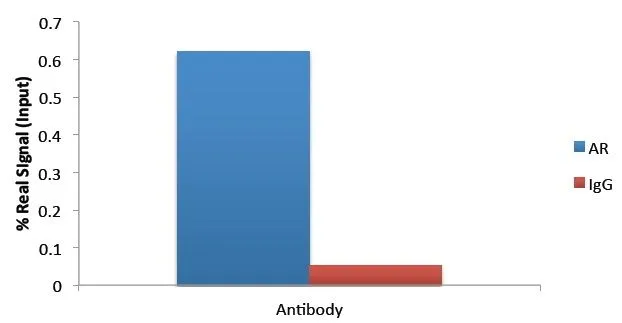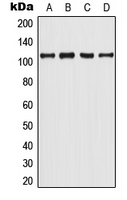![IHC-P analysis of human prostate carcinoma tissue using GTX29474 Androgen Receptor antibody [AR 441]. IHC-P analysis of human prostate carcinoma tissue using GTX29474 Androgen Receptor antibody [AR 441].](https://www.genetex.com/upload/website/prouct_img/normal/GTX29474/GTX29474_20191203_IHC-P_132_w_23060722_648.webp)
IHC-P analysis of human prostate carcinoma tissue using GTX29474 Androgen Receptor antibody [AR 441].
Androgen Receptor antibody [AR 441]
GTX29474
ApplicationsImmunoHistoChemistry, ImmunoHistoChemistry Paraffin
Product group Antibodies
TargetAR
Overview
- SupplierGeneTex
- Product NameAndrogen Receptor antibody [AR 441]
- Delivery Days Customer9
- Application Supplier NoteIHC-P: 1:100-1:200. *Optimal dilutions/concentrations should be determined by the researcher.Not tested in other applications.
- ApplicationsImmunoHistoChemistry, ImmunoHistoChemistry Paraffin
- CertificationResearch Use Only
- ClonalityMonoclonal
- Clone IDAR 441
- ConjugateUnconjugated
- Gene ID367
- Target nameAR
- Target descriptionandrogen receptor
- Target synonymsAIS, AR8, DHTR, HUMARA, HYSP1, KD, NR3C4, SBMA, SMAX1, TFM, androgen receptor, dihydrotestosterone receptor, nuclear receptor subfamily 3 group C member 4
- HostMouse
- IsotypeIgG1
- Protein IDP10275
- Protein NameAndrogen receptor
- Scientific DescriptionThe androgen receptor gene is more than 90 kb long and codes for a protein that has 3 major functional domains: the N-terminal domain, DNA-binding domain, and androgen-binding domain. The protein functions as a steroid-hormone activated transcription factor. Upon binding the hormone ligand, the receptor dissociates from accessory proteins, translocates into the nucleus, dimerizes, and then stimulates transcription of androgen responsive genes. This gene contains 2 polymorphic trinucleotide repeat segments that encode polyglutamine and polyglycine tracts in the N-terminal transactivation domain of its protein. Expansion of the polyglutamine tract from the normal 9-34 repeats to the pathogenic 38-62 repeats causes spinal bulbar muscular atrophy (SBMA, also known as Kennedys disease). Mutations in this gene are also associated with complete androgen insensitivity (CAIS). Alternative splicing results in multiple transcript variants encoding different isoforms. [provided by RefSeq, Jan 2017]
- Storage Instruction2°C to 8°C
- UNSPSC12352203
References
- Identification and Functional Characterization of a Novel Androgen Receptor Coregulator, EAP1. Yokoyama A et al., 2021 Nov 1, J Endocr SocRead this paper
- Phospholipase C (PLC)epsilon Promotes Androgen Receptor Antagonist Resistance via the Bone Morphogenetic Protein (BMP)-6/SMAD Axis in a Castration-Resistant Prostate Cancer Cell Line. Yuan M et al., 2019 Jun 15, Med Sci MonitRead this paper
- TACC2 (transforming acidic coiled-coil protein 2) in breast carcinoma as a potent prognostic predictor associated with cell proliferation. Onodera Y et al., 2016 Aug, Cancer MedRead this paper

![WB analysis of (1) BSA, (2) recombinant protein AR and (3) protein marker using Androgen Receptor antibody [3C6-F12-F11] at a concentration of 0.5 microg/ml.](https://www.genetex.com/upload/website/prouct_img/normal/GTX16032/GTX16032_WB_w_23060620_869.webp)

![IHC-P analysis of human prostate tissue using GTX22742 Androgen Receptor antibody [AN1-15]. A : isotype control B : Primary antibody C : Primary antibody with magnified section Antigen retrieval : HEIR with a buffer (pH 6.2) Dilution : 2 microg/ml](https://www.genetex.com/upload/website/prouct_img/normal/GTX22742/GTX22742_1090_IHC-P_w_23060620_939.webp)

